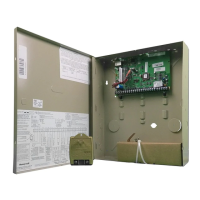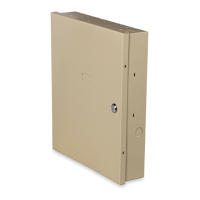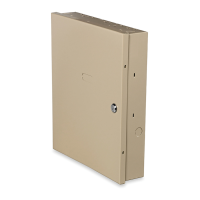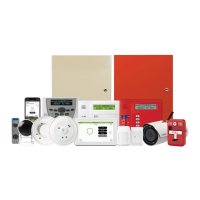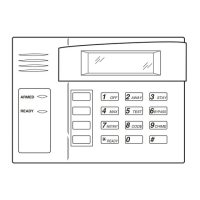∗
∗∗
∗170 Pager 4 Characters
| | | | | | | | | | | | | | |
Enter the optional prefix characters, up to 16 digits.
0–9; #+11 = '
✱
'; #+12 = '#'; #+13 = 2-second pause.
∗
∗∗
∗171 Pager 4 Report Options [0,0,0]
P1 P2 common
See field *162 for reporting options. Select for each partition (use zone
list 12 if using options 12 or 13).
∗
∗∗
∗172 Pager Delay Option For Alarms [3]
0 = none; 1 = 1 minute; 2 = 2 minutes; 3 = 3 minutes
This delay is for ALL pagers in the system.
MISCELLANEOUS SYSTEM FIELDS (*174-*181)
∗
∗∗
∗174 Clean Me Reporting Options [0]
(for ESL smoke detectors)
0 = disable; 1 = Clean Me signal reports;
NOTE:
If Clean Me is enabled, you must enter “3” in field ✱56
programming for zone 1 response time.
∗
∗∗
∗177 Device Duration 1, 2 [0] [0]
(used in *80 Menu mode-Device Actions 5/6) 1 2
0 = 15 seconds 6 = 2-1/2 min #+11 = 7 min
1 = 30 seconds 7 = 3 min #+12 = 8 min
2 = 45 seconds 8 = 4 min #+13 = 10 min
3 = 60 seconds 9 = 5 min #+14 = 12 min
4 = 90 seconds #+10 = 6 min #+15 = 15 min
5 = 2 minutes
∗
∗∗
∗181 50/60 Hertz AC Operation [0]
0 = 60 Hz; 1 = 50 Hz
CONFIGURABLE ZONE TYPE OPTIONS (*182-*185)
(see Configurable Zone Type Worksheet on page 7)
∗
∗∗
∗182 Configurable Zone Type 90
1 2 3 4 5 6 7 8 9 10
Enter the appropriate value for each entry, 1-10, based on the charts
provided on the next page. Each entry is the sum of the values of its
selected options
(0-9, #+10=10, #+11=11, #+12=12, #+13=13, #+14=14, #+15=15).
UL: Do not configure zones as a fire alarm or UL burglar alarm zone.
∗
∗∗
∗183 Zone Type 90 Report Codes
IMPORTANT: Use existing Contact ID® codes, if appropriate, or
define unique codes in CID code range 750-789. See important note
in installation instructions.
90 ALARM ID: XXX
TROUBLE ID: XXX
Enter the desired 3-digit Contact ID® report codes for alarms and
troubles occurring on zones assigned to this zone type. Enter the
codes sequentially (all 6 digits). When entering digits, [#] moves
cursor back, [∗] moves forward.
NOTE: Zone alarm report codes (prompt in ∗56 Menu mode) and
trouble report code (∗60) and relevant restore codes (∗70, ∗71) must
be enabled in order for the configurable zone type codes to be
reported.
Press [∗] when done to continue.
∗
∗∗
∗184 Configurable Zone Type 91
1 2 3 4 5 6 7 8 9 10
See ∗182 for entries. Press [∗] when done to continue.
UL: Do not configure zones as a fire alarm or UL burglar alarm zone.
∗
∗∗
∗185 Zone Type 91 Report Codes
IMPORTANT: Use existing Contact ID® codes, if appropriate, or
define unique codes in CID code range 750-789. See important note
in installation instructions.
91 ALARM ID: XXX
TROUBLE ID: XXX
See *183 for entries. Press [∗] when done to continue.
KEYPAD OPTIONS *189-*196
KEYPAD NOTES:
1. Options for keypad 1, address 16 are set by the factory and cannot be
changed.
2. Each keypad must be assigned a unique address. Keypads programmed
with the same address will give unpredictable results.
3. If using Remote Services (IP/GSM feature), one of the keypad addresses
may be used for limited Remote Services features, though a physical
keypad is not installed. See ∗29 Menu Mode section for enabling Remote
Services.
∗
∗∗
∗189 Touch Screen Device
(
AUI) Enable [1] [1] AUI 1 AUI 2 AUI 3 AUI 4
System supports up to four touch screen style keypads (e.g.,
Symphony Advanced User Interface, and 6270 Touch Screen Keypad).
AUI Compatibility Note: To ensure proper AUI device operation, use
AUI devices with the following rev levels: 6270 series use version
1.0.9 or higher; 8132/8142 (Symphony) series use version 1.1.175 or
higher.
Touch Screen (AUI) device 1: Must set AUI device address to 1
Touch Screen (AUI) device 2: Must set AUI device address to 2
Touch Screen (AUI) device 3: Must set AUI device address to 5
Touch Screen (AUI) device 4: Must set AUI device address to 6
Enter each touch screen keypad’s home partition
0 = disable; 1 = partition 1; 2 = partition 2; 3 = partition 3 (common)
NOTES: 1. Use of touch screen style keypads does not affect the
number of standard keypads supported.
2. If using Remote Services (IP/GSM feature), one of the touch
screen (AUI) addresses may be used for enhanced Remote
Services feature set, though a physical touch screen is not
installed. See ∗29 Menu Mode section for enabling Remote
Services
.
∗
∗∗
∗190 Keypad 2 Device Address 17 [0] [0]
Partition: Enter partition where: Part. Sound
0 = keypad disabled; 1-3 = part. no. (3 = com)
Sound: 0 = no suppression
1 = suppress arm/disarm and E/E beeps
2 = Suppress chime beeps only
3 = suppress arm/disarm, E/E, and chime beeps
∗
∗∗
∗191 Keypad 3 Device Address 18 [0] [0]
See field ∗190 for entries. Partition Sound
∗
∗∗
∗192 Keypad 4 Device Address 19 [0] [0]
See field ∗190 for entries. Partition Sound
∗
∗∗
∗193 Keypad 5 Device Address 20 [0] [0]
See field ∗190 for entries. Partition Sound
∗
∗∗
∗194 Keypad 6 Device Address 21 [0] [0]
See field ∗190 for entries. Partition Sound
∗
∗∗
∗195 Keypad 7 Device Address 22 [0] [0]
See field ∗190 for entries. Partition Sound
∗
∗∗
∗196 Keypad 8 Device Address 23 [0] [0]
See field ∗190 for entries. Partition Sound
∗
∗∗
∗197 Exit Time Display Interval [0]
0 = no display; 1-5 = seconds between display refresh
NOTE: If enabled and using only 2-digit fixed-word keypads (e.g.,
6150RF), do not set exit delay time greater than 96 seconds. See Inst.
Instr. for explanation.
TOUCH SCREEN DEVICE NOTE: If using more than one touch
screen device (e.g., 6270, Symphony) with the system, leave field
*197 Exit Time Display Interval set to the default value “0.” The 6270
automatically displays remaining exit time in one-second increments.
∗
∗∗
∗198 Display Partition Number [0]
(for Alpha Display Keypads)
0 = no; 1 = yes (partition no. appears on Alpha Display)
∗
∗∗
∗199 ECP Fail Display [0]
0 = 3-digit display (“1” + device address)
1 = 2-digit fixed-display as “91”
– 6 –
WWW.DIYALARMFORUM.COM
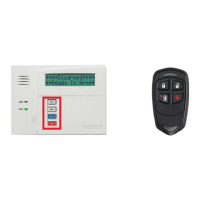
